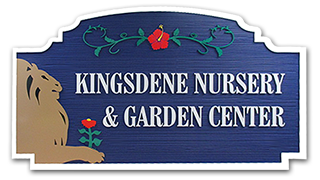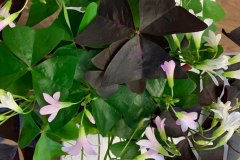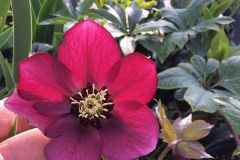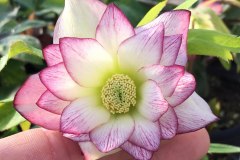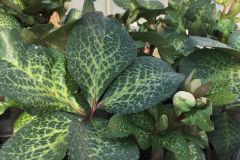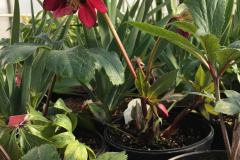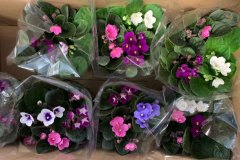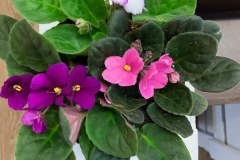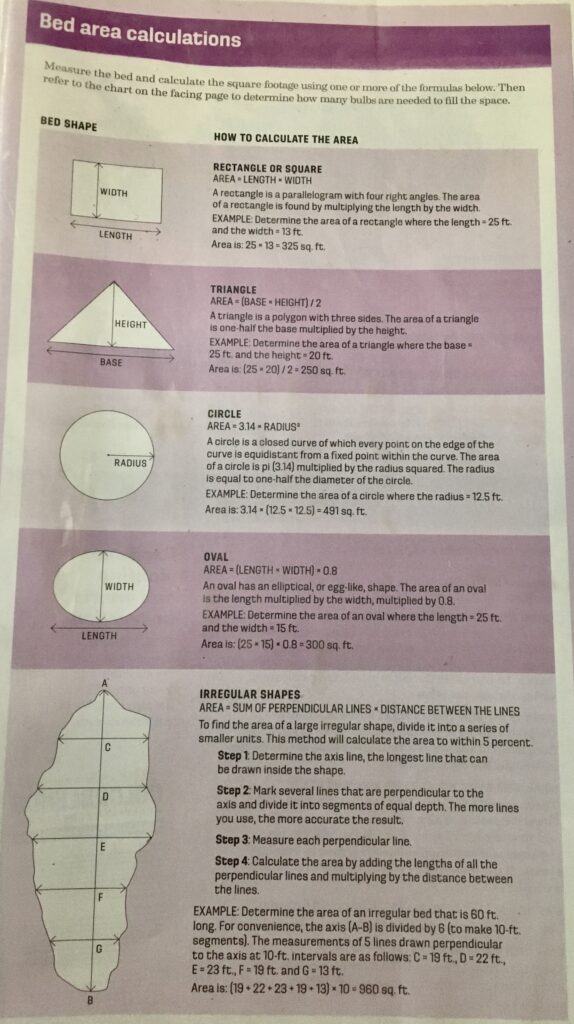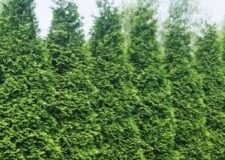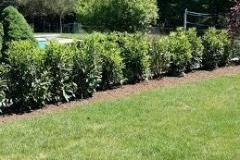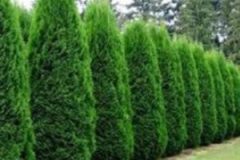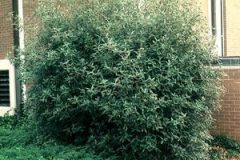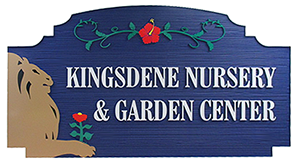We came in today and it looks like the Leprechauns made a delivery, OXALIS! Super easy to grow and another plant that can live with proper care for years. And what is proper care you ask? Well, it’s actually pretty simple. A degree in horticulture is not required to grow this happy little plant. Oxalis has a fun personality all its own. Triangular leaves in shades ranging from emerald green to deep maroon and some are even variegated. You’ll also find some varieties sporting an extra leaf for good measure, just like the lucky four-leaf clover. 🍀 Oxalis are members of the wood sorrel family and are not true “shamrocks”, even though they are more readily available around St. Paddy’s Day. They like a well-drained soil and care should be taken to not overwater. Oxalis are grown from bulbs (corms) and they can rot if overwatered. They like to be placed in an area with bright but indirect light. Low light can make them leggy (and ugly ☹️). Fertilize with a well balanced all purpose food about every 2- 3 weeks when they are actively growing. They do occasionaly have a few nuisance pests like aphids, whiteflies, and spider mites. All in all a great little plant to have in your collection, and one that can provide years of enjoyment. So come on in, and see if you can find one that has a lucky leaf. If you do, it’s calling your name!
“The hills are alive with……no, not music, Hellebores! Our hellebores are waking up! They’re not out on the sales tables yet so come and take an early peek and get the best ones. They don’t mind a chill so they’re ready to go. A sure sign of Spring!
African violets, the memories they bring back of the writer’s “Granny” growing huge and beautiful violets. All while making it look so easy, which it actually is! Today stunning colorful tri-color violets came in to the gift shop. These little beauties will certainly perk up the remaining gray days of winter. With proper TLC they will be repeat bloomers for many years to come, that’s right, we said YEARS! Here are a few tips for growing violets and if you feel overwhelmed come on in and we can answer any questions or concerns you have.
Avoid plants with soft, droopy leaves and those with brown spots or pests. Plants with a few open flowers and many closed buds will remain in bloom longer after you buy it. Tip: peek under the upper leaves to look for newly forming flower stems.
African violets need bright light to bloom, but cannot tolerate hot, direct sun because their leaves are easily scorched by intense light. Violets bloom best at temperatures from 65 to 75 degrees.
In the winter, violets grow best in south, east, or west-facing windows. On cold winter nights, move the plants away from the glass to a spot that remains above 55 degrees. When the sun gets stronger in the spring, move plants to a cooler east or even north-facing window.
Give each plant a one-quarter turn clockwise every few days to keep the growth symmetrical.
Watering is not as complicated as one would think. Water only when the soil surface feels dry. The pot may feel “light”.
Use room-temperature tap water. Cold water shocks the roots and causes leaf spots.
Let chlorinated water sit overnight before using.
Avoid softened water, which is too salty.
Water from the top or bottom, whichever is easier. Soak the soil thoroughly.
Let the pot drain completely; don’t let plants sit in water!
Try to avoid splashing water onto the leaves and never water directly onto the leaves. Use a high quality violet food, we recommend Espoma Organic African Violet Food.
Violets prefer a well-draining potting soil. Try to find a potting soil with a loose peat perlite mix. When you repot from a nursery pots, remember that the new pot should be about one-third to half the diameter of the plant. For example, a 7-9″ plant should be in a 3″ pot. A 9-12″ plant goes into a 4″ pot. Choose shallow pots for best drainage and root aeration. Repot your plant in fresh soil and a clean pot once a year.
Violets are very easily propagated. Often a healthy leaf allowed to root in a glass of water will produce another violet that you might want to pass along to a friend or family member.
Spacing is important. Try to keep your violets from touching each other and to allow for good air circulation around the plants.
When you see the blooms on your violet start to die simply reach in and pinch that bloom off as close to the plant as possible. Nothing makes a violet look more sad than dead flowers.
Violets can be susceptible to some pests, like Aphids and Mealy Bugs. Most pests can be easily treated. If you notice something unusual on your plant, please bring us a photo and we will do our best to diagnose and offer suggestions for treatments. Sadly, there are times when the best we can offer is “last rites” for the plant. But that’s okay, just buy a new one and start over!
Violets, or houseplants in general, are a fun and rewarding hobby!
“What can I plant to screen the neighbors?” is a question we hear year round. While there are many conditions to consider, here are some of our favorite picks.
Just follow these fall tips for pruning and maintenance. It isn’t complicated.
Identify
It is important to identify your variety first because some hydrangea varieties do not like being pruned in the fall.
If your garden has hydrangeas, then you need to know that there are two types of hydrangeas. One type produces flower buds on old wood and the other produces flower buds on new wood. Stems are called old wood if they have been on the plant since the summer before. New wood are stems that develop in the current season. Most varieties found in gardens are old wood bloomers including Mophead, Big Leaf, Lacecap, and Oakleaf hydrangeas. Double check your variety with your local garden center.
When to Prune
Hydrangeas can grow for years without being pruned, but if they get unruly, over take an area of the garden or lose their growing capabilities – it is time to trim. But when to prune them?
Prune fall blooming hydrangeas, or old wood bloomers, after they bloom in the summer. If you prune old wooded hydrangeas in fall, you are cutting off next seasons blooms.
Summer blooming hydrangeas, or those that bloom on new wood, are pruned in the fall, after they stop blooming.
Hydrangeas are colorful and vibrant in the early season, but are hard to preserve after being cut. They are easier to care for after they start drying on the bush.
How to Prune
Near the bottom of your plant, you will see thin, wispy, weak growth. Cut those down. They will take up energy that your plant could use for blooms.
Look for any dead stumps on your stems. They will not have grown any new wood or buds out of the original old wood. Cut the dead stumps down to their base to completely remove them. This will allow the new growth underneath to have a chance to succeed.
Dead and old blooms need to be removed to make room for new buds to come through. Cut the flower head off right above the first few leaves to encourage blooms for the next summer.
Stand back from the plant and observe its shape. You’ll want to prune the shrub into the shape you prefer, a sphere is the typical style but you could prune it into any shape you want!
Clean the Debris
Remove any debris that fell off from the base of the plant. You want to make sure your soil is free of any weeds, leaves and dead flowers.
Fertilize
If you’re growing blue hydrangeas, feed with Holly-tone to keep the soil acidic and the blooms bright. Otherwise, opt for Flower-tone.
For the best hydrangea care, feed 2-3 times throughout the growing season, which is from spring until fall.
Follow these few steps and your hydrangeas will be happy and vibrant for years to come.
According to the US Drought Monitor, Maryland is in the moderate stage of drought.
Now it is especially important to water your plants to help them survive the winter and come back beautiful in the spring. Plants are storing nutrients to help them survive and we can help out by watering. Be sure to soak all around the edge of the plant canopy, which is where the branches end on a plant. This is where the roots are growing and searching for water.
We recommend watering twice a week ( 3 times if your plant wilts before the next watering day)
1 gallon plants need 40 seconds of water
3-7 gallon plants need 40 seconds of water per gallon container
15 gallon and B&B plants need 2 minutes per 3 gallons
If you’re thinking about seeding a new lawn or overseeding your old lawn, don’t forget to water. It has been very dry lately and grass seed needs to be kept moist at all times until it germinates. This means watering 2-3 times a day for 3 weeks in order to keep the seed moist, not wet. The top inch of soil needs to be moist and until the area is densely green you should keep it watered.
